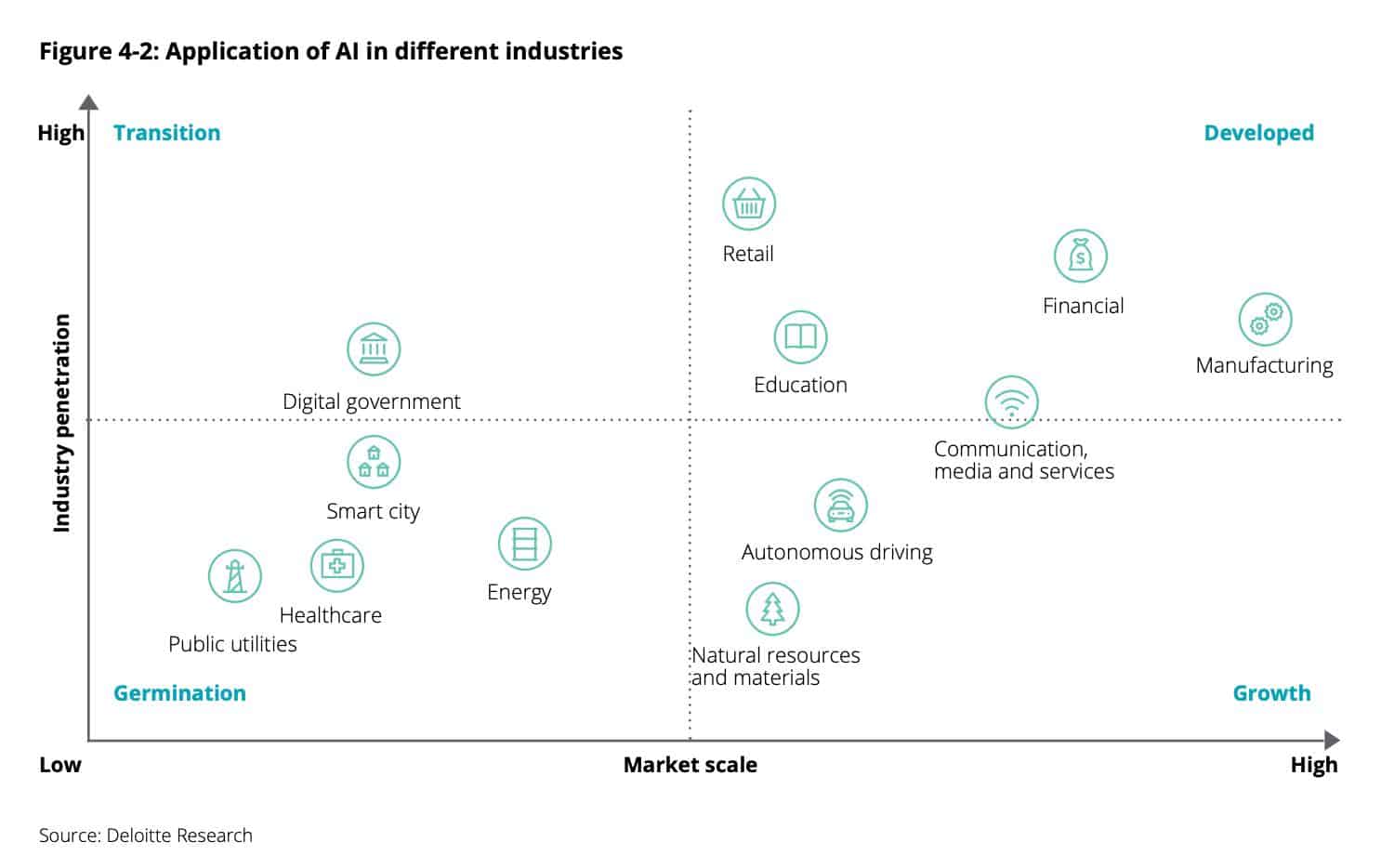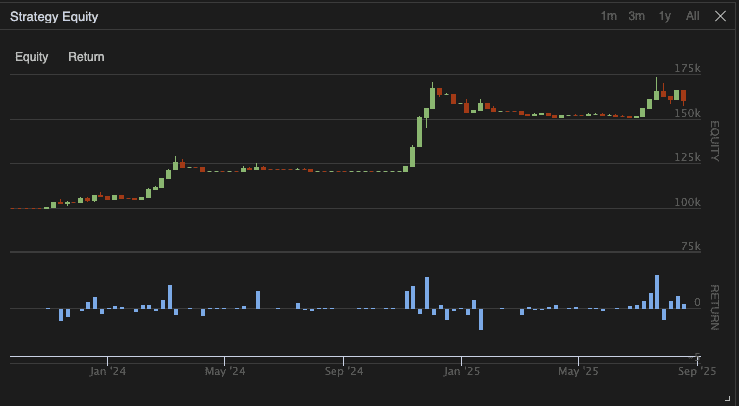“It seems probable that once the machine thinking method had started, it would not take long to outstrip our feeble powers… They would be able to converse with each other to sharpen their wits. At some stage, therefore, we should have to expect the machines to take control.” – Alan Turing
If that doesn’t smash your rose-colored glasses on Artificial Intelligence (or, AI) I don’t know what will. Given the dire (and logical) end-points we can assume about this incredible technology, why not make some money off of it before we’re removed from the equation!
There’s a number of ways to conceptualize what makes a great investment. One of these is to think about an investment opportunity as a function of the growth potential divided by the penetration rate. In this equation, the most attractive investment is one with high growth potential and a low current penetration rate.
And the best place to find these ideas is in the AI space. Like the stages of a company’s development, there are levels (or “Quadrants, as Deloitte highlights) to AI’s industry-specific applications.
These quadrants help us determine what stage an industry is in its AI adoption cycle and allows us to invest in the highest growth areas possible. In short, we can pinpoint specific industries at the cross-section of high growth and low penetration. Our Holy Grail sweet spot.
But before we dive into specific industries and investment ideas, we first need to understand what makes a great AI company.
This essay will cover three topics:
-
- What Makes A Great AI Company?
- What are the Four Quadrants of AI Application?
- Which Industry/Quadrant Do We Want To Invest?
“Come with me if you want to live find awesome investment ideas.” – Terminator (or something like that)
What Makes A Great AI Company?
A great AI company takes internally generated data and uses it to provide a better service/product to its users. Which in turn grows its user base and creates more (and better) data. Which begets a better product. Etcetera.
Great AI companies are true beneficiaries of the first-mover advantage. At the end of the day, whoever has the best data wins. The best data trains the best model which produces the best product.
William Vorhies of Data Science Central calls this idea Data Dominance. Here’s his take on this idea (emphasis mine):
“To create a successful AI company you must create such a wide moat that no one can catch up unless they pay your price. That moat is not about technology. There are essentially no monopolies on deep learning technologies, only leaders that can quickly be copied.The secret to a wide moat in AI is to have a virtual monopoly on the data you are using to train. In this case monopoly also means such a large lead in users and data volume that no one can reasonably catch up.”
But data for data’s sake isn’t enough. Great AI companies need the right type of data. Defensible data. In the case of AI, it’s the data that creates the economic moat, not the technology. In fact, Vorhies argues that the actual technology aspect of AI companies is purely a commodity.
So, we can reduce the formula for a great AI company into two factors:
-
- The company that has a monopoly on the right type of data
- The data is used to solve a specific (niche) problem
Armed with this framework, we scan areas where AI can create both a differentiated data set and solve a unique problem. This process will eliminate most industries from investment. Vorhies reminds us about Facebook and Google’s dominance in advertising, and Amazon’s moat on consumer spending (emphasis mine):
“For example, there’s no wide moat available in advertising. Google dominates search-based advertising and Facebook dominates social media based advertising. General e-commerce? Can’t beat the lead that Amazon has in learning about our personal shopping desires. These three industry giants clearly have defensible positions by virtue of their dominant data.”
Vorheis offered three examples in his blog post:
1. Blue River Technologies
Blue River Technologies has the largest collection of plant images in the world. This allows them to recommend the exact levels of water, nutrients and fertilizers for any plant at any stage of its lifecycle.
That type of data is extremely valuable. So much so that John Deere bought the company for $305M in 2017.
Blue River is a perfect example of defensible datasets and unique problems. Here’s a snippet from a Medium article on the acquisition (emphasis mine):
“Their robots actually sense, decide, act, and learn — millisecond by millisecond. Each year, Blue River robot systems collect all the data from crops over time and close the loop, ensuring they understand the impact of each management decision and optimizing for next year’s crop.”
2. Axon
Axon is an interesting case study. Many people know it by its former name, Taser. Yep, the company that makes the famous stun guns. Seeing a one-and-done sales cycle, Taser leveraged its massive database of video footage from its police body cams.
We’re talking a massive database: 4.9 Petabytes, or the equivalent of the entire Netflix 2016 catalogue.
Like Blue River, Axon’s database housed unique insights into specific problems: audio and visual data from police arrests. Again we see the power of defensible data. Who can compete with 4.9 Petabytes of existing data?
The applications for such data include facial recognition, voice identification and stress prediction. As well as predictive and prescriptive policing policies.
3. Stitch Fix
Stitch Fix is one of the most recent and popular examples of the power of data in analytics.
Bill Gurley, arguably one of the greatest venture investors of all time, led Stitch Fix’s Series B round for $12M. He wrote a great article on the company in 2013 where he strikes at the heart of SFIX’s main competitive advantage, unique data (emphasis mine):
“Stitch Fix’s personalization technology creates a very similar dynamic within women’s fashion. Through a better understanding of the customer, and using data to predict future orders, Stitch Fix has an engine that simultaneously better serves the individual desires of the customer and also contributes to higher inventory turns, fewer write-downs, higher capital efficiency and higher ROIC. This is business model nirvana.”
In short, SFIX’s customers help make the product better. This makes for more happy customers, which creates better data for an even better product. It’s Bill Gurley’s “business model nirvana” and what Vorheis described as defensible data.
This leads us to an important (albeit nuanced) conclusion: data network effects are better signals for potential moats than regular network effects.
Matt Turk (VC at FirstMark) wrote an article on the differences between generic network effects and data network effects. Here’s his take on data network effects (emphasis mine):
“Data network effects occur when your product, generally powered by machine learning, becomes smarter as it gets more data from your users. In other words: the more users use your product, the more data they contribute; the more data they contribute, the smarter your product becomes (which can mean anything from core performance improvements to predictions, recommendations, personalization, etc. ); the smarter your product is, the better it serves your users and the more likely they are to come back often and contribute more data – and so on and so forth.”
What’s interesting is that companies can leverage both types of network effects. Matt gives two examples in Facebook (FB) and Uber (UBER):
“Part of the magic of Uber is that it benefits from both for its core mission: a standard network effect (Uber becomes more valuable for everyone as more drivers and more customers “join” the service) and a data network effect (more data enables Uber to constantly improve its routing algorithms to get customers a car as quickly as possible and to ensure its drivers get as many jobs as they can handle, making everyone happy and more likely to be long term members of the network). Similarly, Facebook benefits from both a “standard” network effect (the more people are on Facebook, the more interesting everyone’s experience is) and data network effects, as the newsfeed, for example, keeps getting more personalized based on massive data learning loops.”
The truly great AI companies leverage both sets of network effects to create the best product and service for its customers. They do this by solving unique problems via insights from differentiated datasets. Defensible datasets. Welcome to the new economic moat reality.
Alright, now that we know what makes a great AI company, let’s learn about the four quadrants of AI Applications. Understanding where an industry sits in its Quadrant helps us determine what type of investment we should make in that space. Or if we should make one at all.
The Four Quadrants of AI Applications
AI’s industry Adoption cycle mirrors that of a company lifecycle. There’s the early stage, high-growth period, maturity and decline. Let’s break each down with Deloitte’s definition and our translated version. Note that for the majority of this section we’ll refer to Deloitte’s whitepaper on the AI industry. It’s a must-read for anyone interested in the space.
Transition
Level of application of AI in the relevant industry is relatively high, but market opportunities are limited currently and the market scale is expected to expand further in the future
Translation: This quadrant has high industry penetration rates and low market scale (opportunities).
Germination
Level of application in the industry and market opportunities are not yet mature, although AI has played certain functions but is still at the initial stage overall speaking.
Translation: This quadrant has low market scale (opportunities) and low industry penetration. Think of Germination as the early-stage venture company with loads of potential but no clear direction.
Growth
Level of application in the industry is not sufficient, but application will broaden in the future with more market opportunities.
Translation: This quadrant has high market scale (opportunities) and low industry penetration. Lots of ideas and not enough solutions.
Developed
AI technology has already had a profound impact on such areas with high level of industry application and market opportunities
Translation: This quadrant has high market scale (opportunities) and high industry penetration. In other words, these industries knew the importance of AI, adopted the technology early and are reaping the benefits of their decision.
Where Industries Fit In Each Quadrant
Now that we know each specific quadrant, we can place each industry into their respective bucket. This is important because it helps us frame where (and when) we want to invest in these industry-specific AI applications.
Transition Quadrant: Digital Government
 Germination Quadrant: Public Utilities, Healthcare, Smart Cities, Energy
Germination Quadrant: Public Utilities, Healthcare, Smart Cities, Energy
Growth Quadrant: Natural Resources and Materials, Autonomous Driving, Communication Media & Services
Developed Quadrant: Communication Media & Services, Education, Financial, Manufacturing, Retail
Generally, we want to focus on the right side of the above graph. We want to invest in industries with large market opportunities and growing industry penetrations. Specifically, we’re looking at four main industries:
-
- Retail
- Healthcare
- Education
- Financial
These four industries offer the perfect mix of opportunity and penetration. Yet it’s not enough to take these industries and call it a day. We must find companies within each industry solving unique problems using differentiated datasets.
The rest of the essay will focus on each industry’s specific pain-points and how companies can use AI to solve those issues. This week we cover Retail and Healthcare.
Retail: All About Customer Stickiness
Today’s customers buy for different reasons than their parents. Now, consumers care more about the social implications of what they buy versus the efficacy of the product. This presents challenges for many retailers as they struggle to understand the “millennial” consumer mind. And they’re fighting an uphill battle. Most retailers’ boards are full of 65+ year old men.
Packy McCormick nails this idea in his newsletter Software Is Eating The Markets, when he says (emphasis mine):
“Like angel investments in the Bay Area, when you add social and experiential value to other asset classes like stocks, sneakers, and cryptocurrencies, price is divorced from hard math and becomes more emotional. That doesn’t mean that people are sitting at home bored and gambling; they may be making perfectly rational decisions when accounting for the many roles their investments are doing for them now.”
Luckily, AI can help retailers keep a pulse on the consumers’ ever-changing behavior.
Deloitte outlined four ways AI can help retailers take back control:
-
- Attracting Consumer Engagement
- Goods Management
- Redefine Stores
- Smart Supply Chain
Two of them (Goods Management and Smart Supply Chain) assist mainly in inventory management and ensuring the retailers orders enough of what’s selling and less of what’s not. For example, companies like ImageDT help retailers organize their shelf space.
Using ImageDT, retail associates can take a photo of a store shelf, and within minutes the company’s AI algorithms recommend optimized product placement, informing you of competitor pricing and how to fill empty space.
Another interesting aspect in the retail space revolves around Redefining Stores. In Gavin Baker’s latest piece, Why category leading brick and mortar retailers are likely the biggest long term Covid beneficiaries, he explains the importance of physical stores for retails future (emphasis mine):
“The future was always going to be omnichannel. Pundits have been prematurely predicting this for many years, but it is finally happening. There is a strange belief in certain circles that the future will be e-commerce only and that brick and mortar stores have no value. This is strange because the worlds largest, most sophisticated e-commerce companies are all opening stores. Lots of stores.”
Gavin goes further with this claim, saying (emphasis mine):
“Brick and mortar stores have tremendous online value in addition to enabling true omnichannel commerce. Nothing matters more for an e-commerce company than marketing efficiency expressed either as gross margin $ payback period or the ratio of CAC to LTV. Brick and mortar stores significantly lower online CAC by improving marketing efficiency (higher click through rates, higher quality scores for ads). Consumers are more likely to trust a brand they have seen in the real world. Ironic in a world where “CAC is the new rent” that one of the best ways to lower your online rent, i.e. CAC, is to pay rent offline for physical stores. Brick and mortar stores also enable BOPIS (buy online pickup in store) and the in-store return of items purchased online, which consumers value.”
If Gavin’s right (and I think he is), this means companies like Geohey become very valuable to commercial retail stores. Geohey leverages its database of economic indicators to help retailers pick the best spot for their new store. Here’s how the company explains their product (emphasis mine):
“The “Jihai Site Selection Solution” quantifies the customer flow, competing products, ecology, consumption, behavior, and location data around the store, and provides full-dimensional indicators for business operations through spatial calculations and geographic statistics.”
Artificial Intelligence helps retailers find and buy the best spots for their specific niche.
Healthcare: The Three Main Drivers of A Complex Industry
It’s astounding to ponder the amount of AI applications in the Healthcare space. It’s also easy to get overwhelmed. Thankfully Deloitte distilled the Healthcare industry’s AI applications to three main focus areas:
-
- Intelligent Health Management
- Intelligent Medical Imaging
- Intelligent Diagnosis and Treatment
In general, AI Healthcare applications care about one thing: personalizing the approach to health and medicine. AI will usher in new waves of personalized medicine, care and treatment. We’re currently seeing this with applications in risk identification, virtual doctors, online diagnosis and precision-based interventions.
Intelligent Medical Imaging is another clear winner from AI adoption. Through image recognition algorithms, scientists can train an algorithm to detect cancer better than humans. And as we mentioned earlier, these algorithms only get better with each incremental image viewed. This ensures better diagnostic accuracy over time, unlike humans which decrease in cognitive function as they age.
Wrap-Up & Lead-In To Next Week
We’re just scratching the surface on industry-specific AI applications. Next week we’ll cover our two remaining industries: education and finance. We’ll dissect major pain points in each of these industries and reveal ways AI is helping solve these issues.
After that, we’ll dive into specific investment ideas fixated on this core theme of Defensible Data and Data Network Effects.
AI is one of the most intriguing thematics to study. There’s tremendous potential for multi-baggers and wide-moat businesses in this space. We can’t wait to find some of those companies with you!







